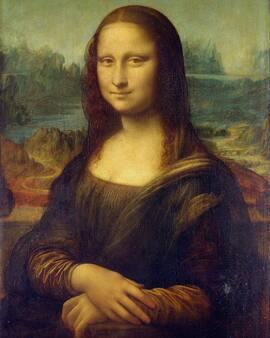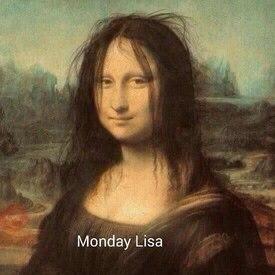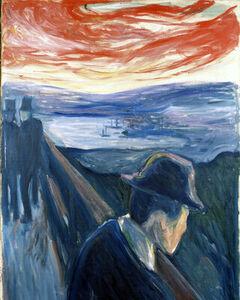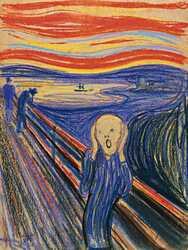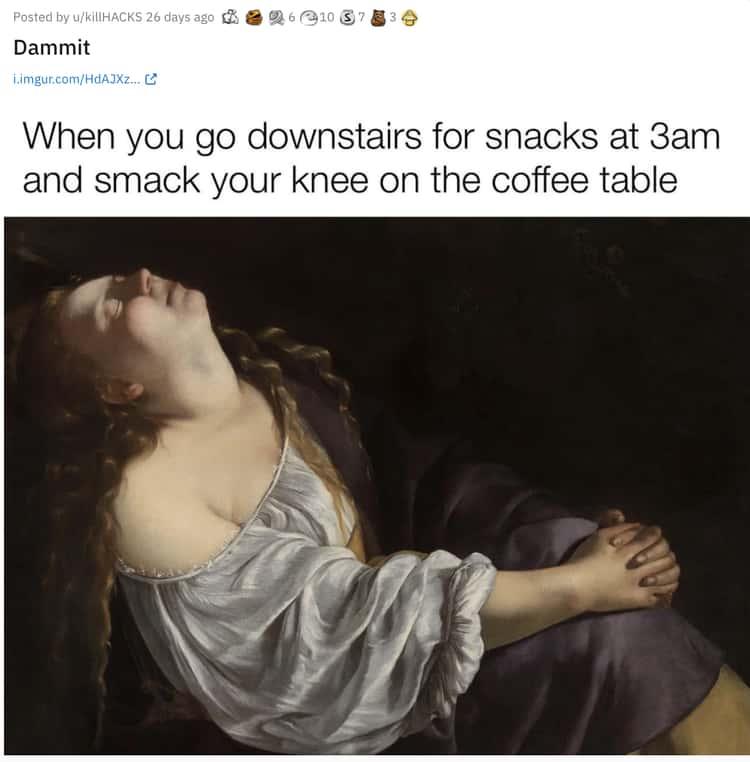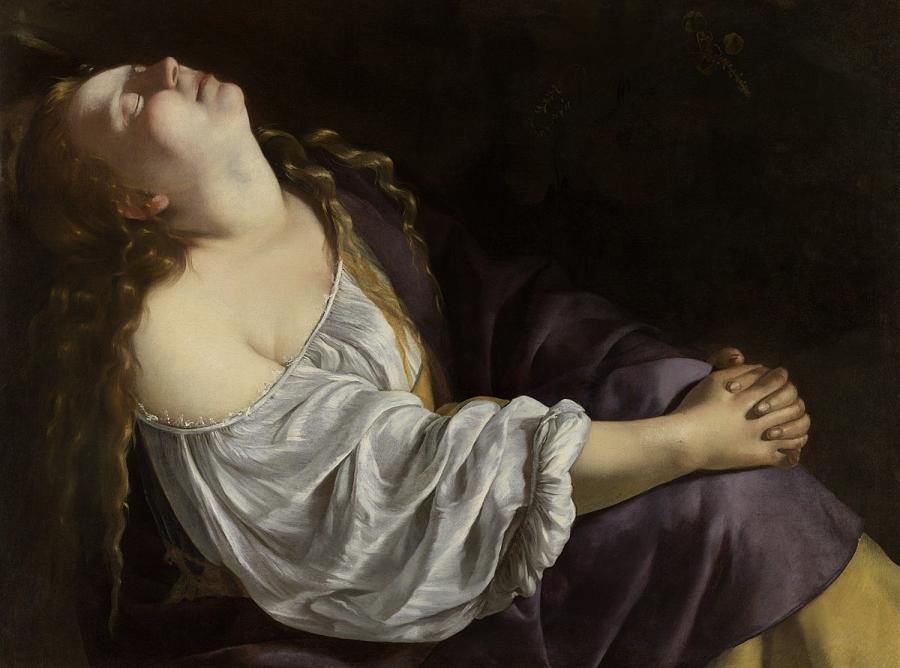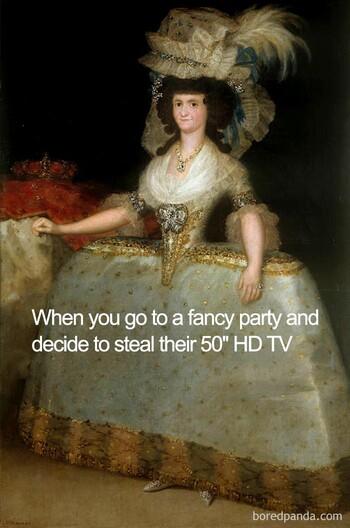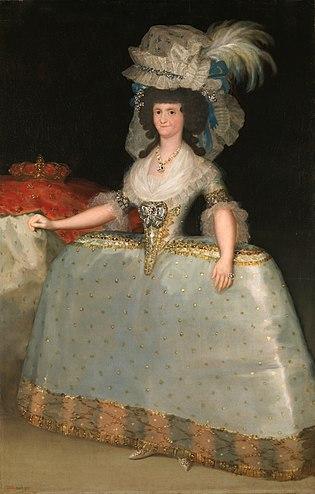
Not just a Meme, a Masterpiece: Literacy in Classical Art Memes
Memes are an important phenomenon in contemporary society. They provide a way for people to connect and share humor and ideas across different platforms and communities. This paper focuses on classical art memes. These memes make use of recognizable images from art history to create humorous and relatable content. In addition, it is a way for people to connect with art and history in a new and entertaining manner. Meme or not, we believe there is a story to be told behind every remix of classical art. This paper dives into the world of stories that are hiding behind classical art memes.
Setting up the Canvas
Memes are part of current online culture. This specific method of communication has been gaining new meaning and function with the technological advances on the internet. Usually made for entertainment, memes have different styles and reach different audiences. The web 2.0 only enhanced this versatility and accessibility.
Drawing on elements of discourse analysis and the concept of remix, this paper analyzes whether the memefication of classical art paintings changes the original literacy of the artwork. In addition to that, it will be discussed in how far the memefication of these artworks disrupts the elitist access to such works that was present before this digitalization. Nowadays, these masterpieces can be seen and shared digitally all over the globe, making these paintings more accessible to larger groups of people.
In order to analyze and understand how memes relate to literacy in classical art, this paperwill briefly introduce memes, highlighting the aesthetics and uniqueness of classical art memes. Then, it will be explained what it means to 'remix', as well as the concept of literacy. Finally, the aspects of analysis will be presented in order to give a better understanding when referenced in the subsequent analysis. After all this, conclusions will be drawn.
Assembling our painting kit: important concepts
In this section, the most important concepts and elements that will be utilizedfor the analysis of the selected classical art memes will be introduced.
Choosing our paints and inks: classical art memes
To understand what a meme is, we also need to understand its history. The term was first coined in the 1970’s, by Richard Dawkins (Raivio, 2016), in a reference to human genes. He claimed that, like genes, the memes would fight for survival and the most “adapted”/adaptable would thrive (citation?).
According to Shifman (2014), memes are collection of digital elements that share similar content, form, or perspective. They are created with an awareness of one another, and widely circulated, imitated, or modified by numerous internet users. They are pieces of public discourse and represent various voices and perspectives. Given this context, classical art memes exist within participatory digital culture (Raivio, 2016). Thus, it is important to understand memes in order to also understand digital culture itself (Börszei, 2013). Technological, cultural and sociological developments enabled memes to evolve into what they are today: a method of communication that has been gaining new meaning and function.
Memes can be made from a still image, an animated GIF, or even a video. For this article, we chose classical art memes that consist of still images. As shown in the first image in this article, a classical art meme is usually a 'remixed' painting with the addition of a written message. A meme itself can be self-contained, meaning it can make sense on its own, but there can also be reference to multiple topics like politics, history, popular culture, and so forth (Raivio, 2016). Memes are usually made for entertainment and can have different styles and formats. They are not meant to be beautiful or present reality accurately, the focus is on the message (Börszei, 2013). The development of tools that enable user-generated content is at the core of the sharing and spreading process, making memes travel worldwide across the internet.
The appropriate brushes: understanding remix
The process of 'Remixing' uses new tools to inspire new learning; it is the creation of a new piece of media which has been altered from its original context, such as: photographs, songs, a piece of art and memes. According to Knobel and Lankshear (2008), the practice was firstly only known for music/sound manipulation, but the current digital environment enables remixing anything.
According to Belshaw (2012), remix is right at the heart of digital literacies. Memes are essentially remixes of cultural elements such as images, videos and phrases that are taken and modified in order to create new meanings or humorous commentary. Therefore, it can be argued that remixing leads to the creation of new forms of literacy.
Preparing the palette: literacy in memes
Literacy is the ability to use your skills and knowledge to interpret different discourses (Gee, 2006). Since this article deals with the knowledge of art in memes, the concept of media literacy is more important; that is: the ability to access, analyze, evaluate and create content in different contexts (Livingstone, 2003). For one to understand the literacy in classical art memes, one should be literate in art, history (for the historical context of the painting), and meme culture (especially if that person intends to remix, share and/or spread the meme). In the analysis we will discuss to what extent all the literacies matter for the meme to achieve its primary goal: entertain.
Drawing the first sketches
To further explore literacy in classical art memes, a multimodal approach will be conducted, to qualitatively analyze selected memes. Multimodality refers to looking at more than one mode of communication in a text to create meaning, such as: text, color and images. It is a method that does not just examine how individual modes communicate, but also how these modes interact with each other to create semiotic meaning (Diggit Magazine, 2020). This multimodal approach will be applied while adding the methodological tool “intertextuality”, which refers to the shaping of a text's meaning by another text. Texts are never entirely new. “We continuously use and re-use elements of discourse borrowed from earlier moments of usage” (Diggit Magazine, 2019). This analysis also takes a closer look at “recontextualization”, which refers to the process that extracts meaning from its original context (decontextualization) and reuses it into another context. Recontextualization therefore implies a change of meaning or redefinition (Blommaert, 2014). This is very similar to the concept of remix. Finally, the concept of indexicality is used. Memes rely heavily on indexicality. An indexical expression is a word or phrase that is associated with different meanings on different occasions (Jan Blommaert, 2020). The analysis will discuss whether the original literacy of the art is important in order for the meme to be successful.
A few brush strokes
Memes have many layers, and the remixes enable them to display several elements at the same time. Although well aware of that fact, we have chosen to highlight only the main features for the memes presented in this article. The first meme is a remix of the classic painting “Mona Lisa”, by Leonardo da Vinci. The original painting, created in 1503, shows a woman, Mona Lisa, in a half-body portrait, with a distant landscape in the background (Image 1).
Image 1: the Mona Lisa
Image 2: Monday Lisa meme
The meme of “Monday Lisa” remixes the “Mona Lisa” painting noticeably . First of all, the words “Mona” were cleverly changed into “Monday”. Therefore, an intertextuality is created, because of the fact that a specific part of the original title of the painting (Mona) was re-used in a new text (combined with the word Monday) - the new name of the painting is “Monday Lisa”, which is based on the original title “Mona Lisa”. Visually, the creator of “Monday Lisa” zooms in the face of the woman, so the whole Mona Lisa painting is not depicted in the meme. Instead of the original perspective, this new version draws the viewer's attention to the woman’s facial features. This in turn reveals that the creator of the meme changed Mona Lisa’s neat hairstyle into a tangled mess. In contrast to the original painting, the mysterious smile of Mona Lisa seems rather restrained here, making it fit perfectly into the new context. She now definitely has the "I'm a mess on Monday morning" or "I don't want to go to work on Monday" look on her face. This is a form of recontextualization, because the original meaning of the classical painting is being extracted (decontextualized) and placed into a new context (Monday Lisa). It is important to notice that even with the new literacy created, a person that is not aware of who Mona Lisa is, will still get the funny pun in the meme. Even an illiterate person in arts can relate to a lazy Monday morning, they will just not understand the reference to da Vinci’s art.
Next, we can see a meme that is a remix of the classic painting “Despair” by Edvard Munch (see image 3). The original painting, created in 1892, depictsa man, wearing a black hat and jacket, leaning on the railing of a bridge. The man is set apart from two other individuals in conversation along the bridge. In the background, the viewer can discern the outlines of a faraway village, its harbor and ships.
Image 3: Despair by Munch
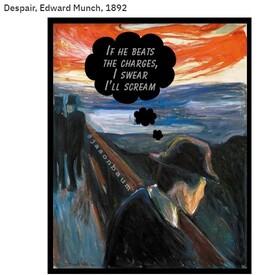
Image 4: Munch meme
Image 4: Scream by Munch
The “Munch meme” (Image 4) uses the same colors from Munch's original "Despair". There is a darker energy that, in combination with the thought bubble, gives the whole scenario a more dramatic weight. One feature that can almost go unnoticed, especially by less literate viewers, is the intertextuality connected toanother one of Munch’s paintings, called “The Scream” (1893) (Image 5). Both “Despair” and “The Scream” share common elements. Within this remix there is a strong use of multimodality. When looking at the painting of “The Scream” and “Despair”, it is clearly visible that the creator of the meme sticks to similar color patterns of both paintings within the remix. The vivid, flaming orange colors of the sky are especially prominent and a clear reference to the original paintings. In addition, intertextuality is used here. In the remix, a reference is made to the painting of “The Scream” by the added text "If he beats the charges, I swear I'll scream". When someone has an understanding of what “The Scream” looks like, the meaning of the remix will be understood.
The next meme (Image 6) was created by remixing “Mary Magdalene in Ecstasy”, originally painted by the Italian painter Artemisia Gentileschi (Image 7). The meme's headline reads“When you go downstairs for snacks at 3am and smack your knee on the coffee table”.
Image 6: Coffee table meme
Image 7: Mary Magdalene in Ecstasy
One thing that can be said is that most people will be able to relate to this kind of situation. In this meme, one element can respond to many situations, which means indexicality is being used. In this case, the creator of this remix has smartly used the painting itself (original element) and applied a new textual reference that also suits the facial expression and physical posture of the woman in the painting. With the remix, it now looks like Mary Magdalene has just smacked her knee and is in a lot of pain. Obviously this is not the original meaning of the original painting, however, this meme is a perfect example of the fact that people do not always require knowledge of the original painting itself to understand its new meaning. Hence, recontextualization is being created, once the classical painting is extracted (decontextualized) from its original context and placed into a new one.
Last but not least, the 50" HD TV meme (figure 8), which is a remix from “Maria Luisa Of Parma Wearing Panniers” (image 9) This artwork was painted by Francisco Goya, the court artist to the royal family, in 1789. This is one of the many paintings in which he portrays Maria Luisa and her panniers which set a perfect canvas for remixes and memes.
Image 9: Maria Luisa Of Parma Wearing Panniers
Fashion has changed a lot throughout the centuries. However, the dated panniers worn by Maria Luisa give the creator of the meme the perfect opportunity to revise the big canvas of the garment into something more relatable - the 50" HD TV. In this way, indexicality is used, as the creator of the meme has connected the shape of the panniers to a modern television screen. When looking at the meme, it really appears like the woman has a television screen hidden under her dress. Again recontextualization is being created, because something in the classical painting is being extracted from its original context (panniers) and placed into a new one (50” HD TV). As with the previous meme, this is obviously not the original meaning of the original painting. However, again, it is not essential to have knowledge of the original painting itself to understand its new meaning. If you do not know who Maria Luisa is, you will still understand the meaning of the meme as long as you are familiar with the shape of a television screen (which most people are). That being said, if the viewer has an understanding of the clothing that women wore during this respective era, the joke of the creator (comparison made between the panniers and the TV screen) will probably be better understood and therefore be more entertaining.
Painting our art work
As can be seen above, some of the memes present general information such as the name, year and creator of the painting, whilst others do not. None of the memes were placed next to the original painting on the social media platforms, so if the reader wants further information on a certain image, they would need to research it for themselves. It has already been stated that memes are made for entertainment (Börzsei, 2013), so being literate in art can help one understand or better place a meme within a historical timeframe. But, as far as it concerns the meme to achieve its goal, it can be concluded that it is not strictly necessary to have prior knowledge about the paintings itself. The examples chosen for the analysis also showed that memes have many different layers; and although being literate in art can take the reader one step further on recognizing the painting, an understanding of elements and concepts such as intertextuality or indexicality, will not always be present.
Despite the fact that these memes make a joke of the classical paintings, it is also important to recognize that there is an educational aspect to the memefication of such art as well; these paintings are made more accessible to a larger group of people. The art that once was only available to the elite and could only be viewed in museums, is now traveling across the internet, with a different purpose (entertain) and imbued with new literacies (remixed). Today, classical art is available to just about everyone. All you need is a digital device and a sense of humor.
References
Belshaw, D. a. J. (2012). The essential elements of digital literacies: A Pragmatic Investigation.
Blommaert, J. (2014). Pragmatics and discourse. Tilburg University.
Börzsei, L. K. (2013). Make a meme instead. The Selected Works of Linda Börzsei, 1-28
Diggit Magazine. (2019, September 11). Intertextuality.
Diggit Magazine.
(2019, May 20). Memes.
Gee, J. P. (2006). What is literacy? Relations, locations, positions: Composition theory for writing teachers, 29-39.
Jan Blommaert. (2020, June 16). Jan Blommaert on Indexicality [Video]. YouTube.
Knobel, M., & Lankshear, C. (2008). Remix: The art and craft of endless hybridization. Journal of adolescent & adult literacy, 52(1), 22-33.
Livingstone, S. (2004). What is media literacy?. Intermedia, 32(3), 18-20.
Raivio, O. (2016). Classical art memes as an affinity space: a faceted classification of an online entertainment page, 1-22
Shifman, L. (2014): Memes in Digital Culture. Cambridge, MA: The MIT Press.
